The field of medical visualization and diagnosis has witnessed significant advancements with the introduction of hysteroscopes. These devices, which are compatible with endoscopes and various medical devices and equipment, play a crucial role in gynecological procedures and diagnostic interventions.
Understanding Hysteroscopes
Hysteroscopes are specialized medical instruments designed for visualizing and examining the inside of the uterus and the cervix. They consist of a thin, lighted telescope-like device that is inserted through the vagina and cervix into the uterine cavity, allowing medical practitioners to visually inspect the internal structures and detect any abnormalities.
These instruments are equipped with high-resolution cameras and lenses, enabling clear and detailed imaging of the uterine cavity. The live video feed from the hysteroscope can be transmitted to a monitor, providing real-time visualization for accurate assessment and diagnosis.
Compatibility with Endoscopes
Endoscopes are another category of medical instruments used for minimally invasive visualization of internal organs and structures. Hysteroscopes share similarities with endoscopes in terms of their design and functionality, making them compatible with endoscopic systems.
Medical facilities equipped with endoscopy suites can incorporate hysteroscopic procedures seamlessly into their existing infrastructure, leveraging the familiarity and compatibility between hysteroscopes and endoscopic equipment.
Integration with Medical Devices and Equipment
Advancements in medical technology have led to the integration of hysteroscopes with various medical devices and equipment, enhancing their capabilities for diagnostic and therapeutic interventions. For instance, specialized instruments such as tissue resection devices, biopsy forceps, and fluid management systems can be utilized in conjunction with hysteroscopes to perform minimally invasive surgical procedures and tissue sampling.
The compatibility of hysteroscopes with advanced imaging platforms, such as high-definition monitors and digital recording systems, allows for the documentation and storage of hysteroscopic procedures for future reference and analysis.
Applications in Gynecological Procedures
Hysteroscopes have revolutionized the field of gynecology by enabling minimally invasive diagnostic and surgical interventions. They are prominently used in procedures such as hysteroscopy, which involves the inspection of the uterine cavity for abnormalities such as polyps, fibroids, and adhesions.
Additionally, hysteroscopic procedures, including endometrial ablation and the removal of intrauterine devices (IUDs), can be efficiently performed using hysteroscopic guidance, minimizing patient discomfort and recovery time.
Advancements in Hysteroscopic Technology
The continuous evolution of hysteroscopic technology has resulted in the development of innovative features and capabilities. Modern hysteroscopes offer enhanced maneuverability, ergonomic designs, and improved visualization systems, empowering healthcare professionals to conduct precise and accurate examinations and procedures.
Furthermore, the integration of advanced optics, such as high-definition imaging and 3D visualization, has elevated the diagnostic accuracy and procedural outcomes associated with hysteroscopic interventions.
Conclusion
Hysteroscopes have emerged as indispensable tools in gynecological practice, offering unparalleled visualization and diagnostic capabilities for a range of uterine conditions. Their compatibility with endoscopes and various medical devices and equipment underscores their versatility and integration into modern healthcare settings.
As the field of hysteroscopic technology continues to advance, these devices are poised to further enhance the precision and efficacy of gynecological procedures, ultimately benefiting both patients and healthcare providers.


